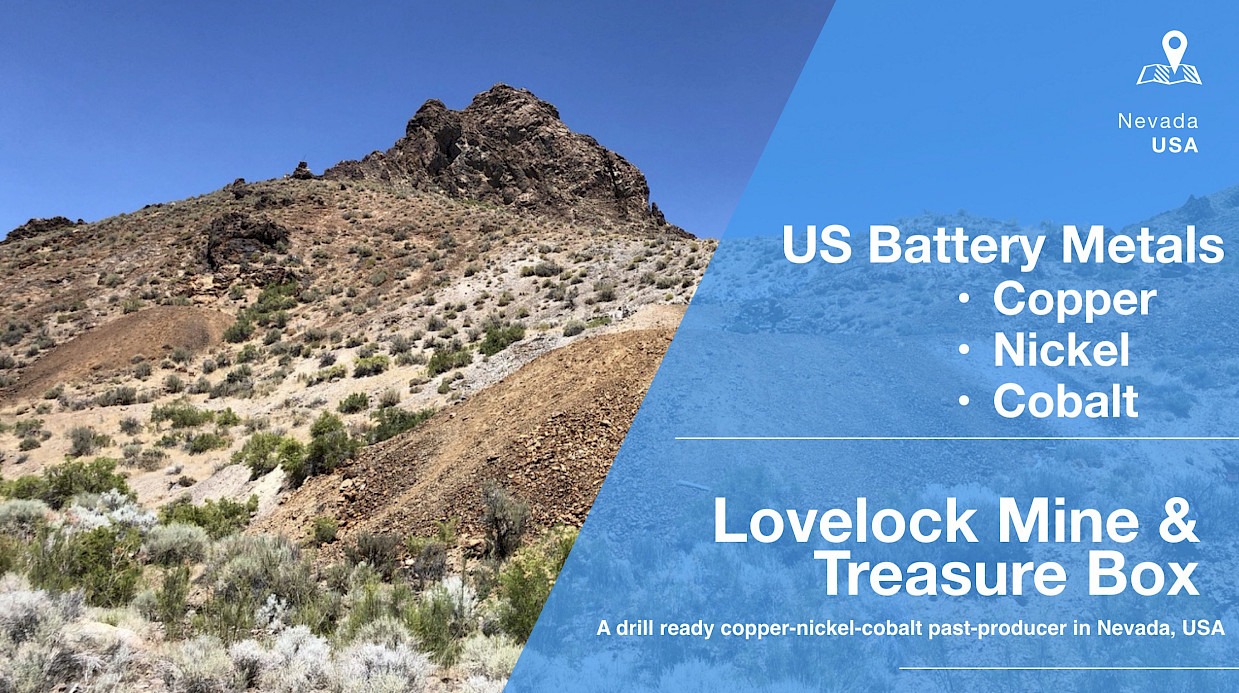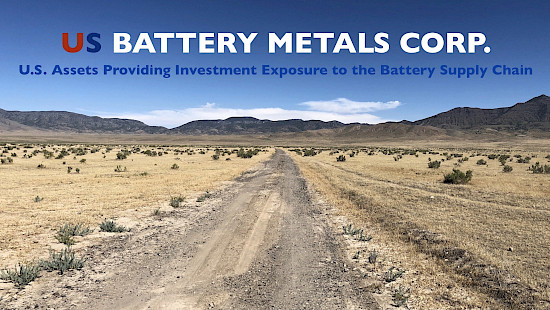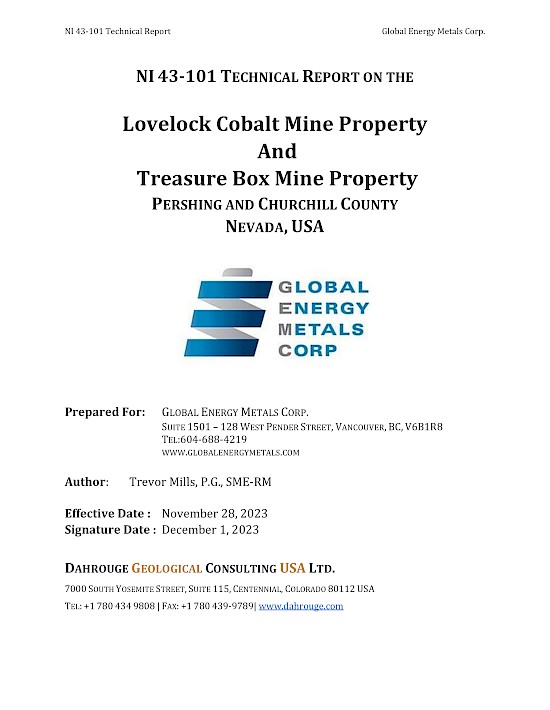Lovelock Mine & Treasure Box Projects - Nevada, USA
-

Location
Churchill County, Nevada - United States of America
Resource Estimate
No Resource Estimate in place
Highlights
• Nevada Cobalt: The right place at the right time in a superior mining jurisdiction which hosts several copper-gold projects nearby and benefits from having excellent infrastructure.
• Strategically Situated: Located in the Stillwater Range with good access, infrastructure in place and only 150 kilometres east of Sparks Nevada, home to - Tesla’s Gigafactory 1.
• Historic Producer: Limited, yet high-grade, production of cobalt, nickel and copper in the 1880s but the area has never been thoroughly explored in the modern era.
• High-Grade Cobalt: The general average of the 200 tons shipped in 1886 averaged 14 percent cobalt and 12 percent nickel (Source: "Mineral Resources of the United States for 1886”).
• Drill Ready: Eight diamond drill targets have been identified in addition to geological mapping, chip and channel sampling and geophysics.
• District Opportunity: Region shows strong enrichment in cobalt, nickel and copper making it very attractive for further exploration and expansion through other attractive growth opportunities.Project Status
Discovery-stage Exploration
Ownership
100% interest in both the Lovelock Mine and Treasure Box projects through its 100% owned subsidiary U.S. Battery Metals Corporation.

Ownership
Global Energy Metals, through its 100% owned subsidiary - U.S. Battery Metals Corp. - has acquired an 100% interest in the Lovelock & Treausre Box projects (the "Property"), subject to a 2% net smelter royalty in favour of Primus.
NI 43-101 Technical Report
Global Energy Metals Corporation retained Trevor Mills of Dahrouge Geological Consulting USA Ltd. (“Dahrouge”), who prepared an independent Technical Report on the Projects, located in Pershing County and Churchill County, Nevada, USA.
The Lovelock Mine Property consists of 27 contiguous unpatented lode mining claims in Pershing County, Nevada and 63 unpatented lode mining claims in Churchill County, Nevada covering approximately 1,813 acres. The Treasure Box Property consists of 76 contiguous unpatented lode mining claims in Churchill County, Nevada, covering approximately 1,561 acres.
This Technical Report has been prepared in compliance with regulatory disclosure and reporting requirements as outlined in Canadian National Instrument 43-101 – Standards for Disclosure for Mineral Projects (“NI 43-101”), companion policy NI 43-101CP and Form 43-101F1 – Technical Report. The Qualified Person responsible for this report is Trevor Mills, P.G., SME-RM, a Principal Geologist with Dahrouge Geological Consulting USA Ltd.
The purpose of this report was to provide a review of GEMC’s Lovelock Cobalt Mine and Treasure Box projects located in Nevada, USA. The report is being used to consider, evaluate, and compare options for the purpose of identifying opportunities to maximize the value for GEMC shareholders. The report is part of GEMC’s strategic review to summarize the previous exploration conducted on the Property and provide recommendations for future work.
Interpretation & Conclusions:
Work conducted to date by GEMC has successfully advanced understanding of the geology and mineralization at both the Lovelock Cobalt Mine Property and the Treasure Box Property. A combination of sampling programs, geophysical studies, and a drilling program have provided successful results that confirm historical mineralization and confirm work by recent owners of the properties. Underground mapping and sampling identified N40E and N75W structural controls and post-mineral faulting at the Lovelock Cobalt Mine. Results of a limited drilling program in 2022 indicate a 9- to 16-meter-thick zone of Co-Ni-Cu mineralization in the hanging wall of the N40E fault that corresponds to a chargeability high identified in a 2018 DC/IP resistivity survey. Geophysical magnetic surveys of the Lovelock Cobalt Mine property were able to partially distinguish major lithologies, correlate linear magnetic features with mapped surface faults, and potentially identify alteration within the mafic lithologies.Magnetic surveys at the Treasure Box Property have successfully identified several faults within mafic HMC rocks that are interpreted to continue under the overlying rhyolitic extrusive rocks. Numerous magnetic-high anomalies also correlate with previously identified soil anomalies for base and precious metals (Au, Ag, Zn, Cu). A mineralized oxide zone has been partially delineated with trenching, surface sampling, and drillholes. Many faults interpreted from the magnetic surveys correspond to mapped surface faults highlighting the effectiveness of the method. Machine learning using geophysical data and remote sensing multispectral imagery was used to correlate clustered data to known geology and improve geological contacts and generate prospective targets. A ground-truthing sampling program of these targets returned positive results.
The successful results using geophysical methods encourages further utilization. Additional IP surveys and/or controlled-source audio magnetotellurics/magnetotellurics (CSAMT/MT) Hybrid-Source Audio-Magnetotellurics (HSAMT) can be considered to provide further definition of geological features. Ground truthing of features via detailed geological mapping is encouraged. Gross geological units have been defined; however, understanding the details of the mineralized units will require quality geological mapping of lithology and alteration. Systematic rock and soil sampling will also provide important data to combine with mapping and new geophysical surveys to further understanding of mineralization on the Property.
Positive exploration results at both properties continue to indicate the potential at each location and follow-up work should be planned. Positive exploration results at each property to date suggest the potential to advance the extent of known mineralization. Known mineralization trends are also present within the patented claims near each property and may represent extensions of mineralization within GEMC’s holdings.
The Author concludes that the Lovelock Cobalt Mine Property and the Treasure Box Property are properties of merit and warrant continued exploration.
About the Lovelock Mine
The Property currently consists of 81 unpatented lode claims in the Cottonwood Canyon area of the Stillwater Range totaling approximately 1,586 acres (642 hectares). It was discovered by George Lovelock and Charles Bell about 1880. According to U.S. Government annual reports, the Lovelock Mine saw limited production of nickel, copper and cobalt beginning in 1883. The primary cobalt mineral was identified as “cobaltite”. The general average of the 200 tons shipped in 1886 averaged 14 percent cobalt and 12 percent nickel. The mine operated from 1883 to 1890 to the 100 foot level, reporting 500 tons of cobalt and nickel mineralized material shipped to England for processing. After intermittent production, an English company attempted smelting on site in 1898 but little or no production was made (Source: “Mineral Resources of the United States for 1885”, 1886). No further production from the Lovelock Mine is known for well over a century providing GEMC an excellent opportunity to unlock the potential value of the deposit through exploration work. During the first ever modern-day drill program conducted at Lovelock by GEMC, elevated values of cobalt, nickel and copper were intercepted in three of the holes which targeted possible mineralization beneath the historical mine workings.
About the Treasure Box Project
Treasure Box hosts mine workings from limited copper production, which occurred until early into the 20th century. A historical diamond drill hole (circa 1910) drilled at the Treasure Box by the Boyer-Nevada Copper Company reportedly intersected 1.52% copper over 85 feet (25.9 metres) with mineralization beginning at surface. A reverse circulation hole drilled on the Treasure Box by Utah International in 1976 returned 1.55% copper over 40 feet (12.2 metres) from a depth of 85 to 125 feet (25.9 to 38.1 metres), and the hole was stopped in chalcopyrite mineralization. The core Treasure Box claims were held continuously for over 20 years by a private company but were relinquished in September 2017, leading to their acquisition by Nevada Sunrise. GEMC received approval from the US Bureau of Land Management (the “BLM”) for a proposed exploration and drill plan at the Treasure Box project that includes up to thirteen (13) vertical drill holes from thirteen (13) different locations. Planned drill hole lengths range from 350 feet (107 metres) to 500 feet (152 metres). Total drilling is anticipated to be 5,850 feet (1,784 meters), with a minimum drilling length of three (3) drill holes totaling 1,350 feet (412 metres). Depending on findings, individual drill hole lengths could be extended by 30 to 50 feet (10 to 15 metres) as determined by the company’s on-site representative. Targeted prospects have been identified by Global Energy Metals through a systematic exploration program that lasted several months and included an airborne magnetic survey, reinterpretation of historical Induced Polarization (IP) data, detailed mapping and desktop review of historical data including past drilling.
Qualified Person
Mr. Paul Sarjeant, P. Geo., is a Director and the qualified person for the Company as defined by National Instrument 43-101 Standards of Disclosure for Mineral Projects and has reviewed and verified the technical information contained herein.

